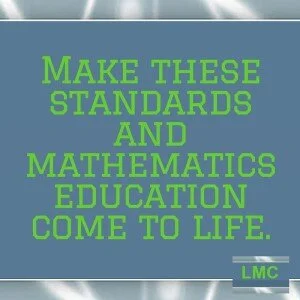Teach them to Think .. and the Rest will Follow!
This Thanksgiving season, I am thankful that we have an answer about the future of testing in Massachusetts. We can now move onto the real conversation – how to best teach children mathematics. Whether we agree or disagree with the vote of the MA DESE (to keep state control over testing, blending MCAS and PARCC questions), I am celebrating an end to living in the limbo between tests. Since 2011, we have had updated standards based on the Common Core for State Standards. We can no longer call these standards new. It is time to focus our attention on making these standards and mathematics education come to life. Our focus should not be on how to cover the standards, but rather on how to make them meaningful, how to teach with engagement and understanding, and how to inspire a lifelong love of mathematics.
Keith Devlin (The Science of Patterns, 1997)writes, “there is scarcely any aspect of our lives that is not affected to a greater or lesser extent, by mathematics; for abstract patterns are the very essence of thought, of communication, of computation, of society, and of life itself.” As we look to the 21st century skills expected of our graduates, it is imperative that we teach our students how to think. It is through the subject of mathematics that we have the opportunity to develop higher level problem solving skills.
Developing mathematical thinking involves teaching numeracy.
Pearse and Walton in their 2011 book Teaching Numeracy tell us “Numeracy is braiding together mathematics, language, and thinking. It is an appreciation of common numerical sense with a depth of reasoning and critical thinking around how numbers change our world.” We are reminded of the connection of math and language. Our thoughts and our ability to communicate thoughts inherently involves language.Even if we think in images and symbols, we attach language - actual words - to communicate and give meaning to these images. We cannot separate our thoughts in mathematics from our use of language – they are “braided together.” This is an important recognition, particularly in an error of lamenting story problems as having “too much language.” We need the words to make the mathematics meaningful and to convey and develop understanding. We cannot divorce the two from thinking.
So, how do we develop numeracy?
We use what we know from cognitive psychology and brain science as it is translated into classroom instructional practices by experts in the field. Pearse and Walton describe 9 critical habits that sound very much like teaching literacy including the following: repairing understanding, developing schema, predicting, inferring, questioning, and developing vocabulary. According to Jo Boaler, we encourage a growth mindset and we celebrate the value of mistakes in brain development and learning (Mathematical Mindsets, 2015).Kazemi and Hintz tell us to use Intentional Talk in their book of the same title (2014). And some of the best and brightest are exploding social media and the internet with freely shared, innovative and creative tasks like those found at www.yummymath.com and www.mathalicious.com.
So while I am concerned about the test results, and the coverage of the standards, my purpose in education is greater. My call for change is deeper.
Engage students.
Choose worthwhile tasks.
Be intentional in your questioning.
Teach for conceptual understanding.
Allow productive struggle.
Let the students do the math.
Explicitly work with students on how to think through problems.
If we teach with these demands in mind, I am confident the test results we are shooting for will follow. But more importantly, our students will possess transferrable skills that carry them well beyond our classrooms and the tests.


